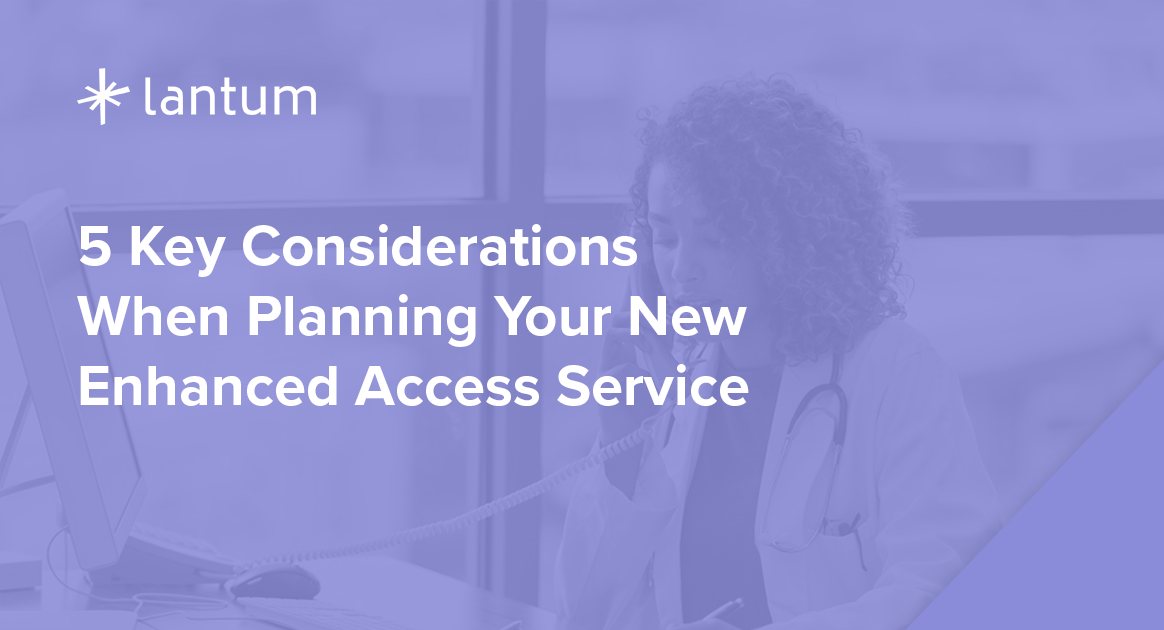5 Key Considerations When Planning Your New Enhanced Access Service
With the extended access contracts moving into Directed Enhanced Service (PCN DES) in October 2022, there are still lots of questions around how it can be implemented successfully.
We recently brought together a panel of experts who are already delivering the service to share how this new model can facilitate an improvement in the quality of patient care. In this article we share the 5 key takeaways from the session that you should consider when planning and implementing your own Enhanced Access services.
1. You can’t have a one-size-fits-all approach to Enhanced Access
Enhanced Access can’t be delivered in siloes - you need to look at the bigger picture to ensure your services are successful across the board.
This resonates strongly with the thoughts Jane Sadler, Head of Primary Care Access at Leeds GP Confederation, shared. She noted that the response to Enhanced Access has been mixed across the 18 PCNs she oversees. Each PCN has different needs so, rather than creating one template for Enhanced Access that would be used across all 18, instead she looked at what services could be delivered for each PCN that would really support routine GP services alongside longer-term care and chronic illness management.
2. Enhanced Access is not a tick box exercise
Once you’ve set up Enhanced Access services across your organisations and region, the work is not done. For them to continue to be successful, you need to continuously review whether they’re working.
Implementing the new model should not be treated as a tick box exercise you need to complete, but can then move on from. The services need maintenance to ensure they continue to deliver appointments and care that meet patients needs.
3. You can reach more patients through Enhanced Access
Enhanced Access is a real opportunity to improve patient care for people in deprived areas, as well as people who can’t make core hour appointments due to work commitments. It also gives you the resources and tools to reduce inequalities in patient care.
It’s all about having appointments that people can access across all the care services GPs deliver, and ensuring there is continuity in those appointments.
4. Data is key to delivering successful Enhanced Access services
Patient data plays a key role in determining whether your Enhanced Access services are delivering and, if leveraged properly, can provide an opportunity to offer broader care across your region with a more multidisciplinary focus. You should monitor the data from Enhanced Access regularly to ensure practices are leveraging the extra appointments.
Data sharing is also key. Work on success measures with your member practice and ensure reporting of success measures is accessible to them too.
Used correctly, data gives you the infrastructure to flex and surge services based on patient needs, and be more targeted in the care we deliver.
5. Patient engagement is critical to success
For Craig Nikolic, Chief Operating Officer at Together First CIC, Enhanced Access gave him the opportunity to really listen to their patients and understand what their preferences are. He found that demand for telephone appointments was actually higher than expected, which allowed the Federation to deliver more of these.
Through engaging with the population Leeds GP Confederation cares for, Jane was also able to tailor the Enhanced Access services offered to better meet patient needs. They found that older patients who needed carers were struggling to attend daytime appointments during the week and therefore offered more weekend appointments, which has had a really positive impact.
Engaging with your patients and understanding local needs will help ensure the success of your new services. When planning your Enhanced Access services, you should try to tailor your approach to different areas and patient needs with these additional resources and appointments.
-
Whilst planning your new Enhanced Access services - whether you’re a PCN or Federation - take into consideration the key takeaways shared above and you’ll be able to deliver successful services that meet patient needs.
Having worked with Extended and Enhanced Access Services across the country for a number of years, Lantum has the experience and software in place to help you implement the new model. Key ways we can help include:
- Lantum’s reporting feature gives you full visibility over data and analytics, enabling you to quickly identify problem areas and dedicate resources to resolve them.
- You have the ability to fill rotas 3 months in advance, giving you valuable time to plan ahead for any gaps in your rota.
- Through Lantum’s staff pool feature, you can share staff and fill rota gaps across your PCN - your ICS may already have adopted this, so ask if you’re not sure.
- Lantum does clinical governance checks for you, so all clinicians are CQC-approved and ready to work.
To chat to one of our team about your Enhanced Access services and how Lantum can help deliver them, click the button below.



